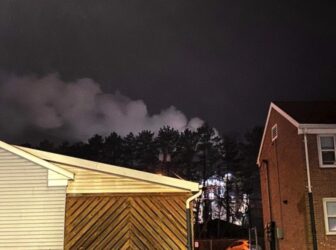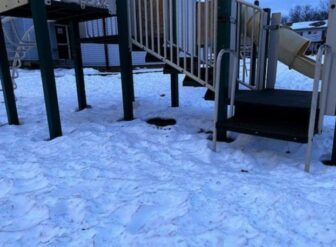
Smoke from Norlite pollutes the sky near the Saratoga Sites Public Housing community. Image: Joe Ritchie
By Kristia Postema
Editor’s note: This is part of a package of three articles and a podcast about green justice – environmental justice – in the Great Lakes region.
The city of Cohoes, N.Y., was founded in 1630.
Rich in history, the downtown district is a hub for tourists and history buffs alike.
But what these visitors don’t know is that just 2 miles south of city center sits the Saratoga Sites public housing community and the Norlite Hazardous Waste Incinerator.
Joe Ritchie has lived in Cohoes, a suburb of New York’s capital, Albany, his entire life. As a current tenant of Saratoga Sites, Ritchie is reminded of Norlite’s close proximity to his home every day.

This is part of a package of three articles and a podcast about environmental justice in the Great Lakes region.
He said smoke and dust from the incinerator pierce the air and cause daily problems for Saratoga Sites residents.
“Sometimes I can’t even get my mail because of how bad the smell from Norlite is,” Ritchie said.
In March 2021, the New York Department of Environmental Conservation (DEC) released a study of PFAS and metals in the water and soil near the facility and said its “comprehensive” analysis found “no clear link to Norlite’s operations, no indication of human health risk.”
The study came in response to community concerns about possible impacts of Norlite’s former incineration of fire-fighting foam.
After the DEC report came out, the CEO of Tradebe USA, Norlite’s parent corporation, issued a statement saying, “These findings confirm that our state of the art technology is protective of our community and the environment, and we hope these conclusions are reassuring to our neighbors.”
“These findings are consistent with numerous studies that confirm the effectiveness of our processes and of our emissions control technology, and again affirm the science that combustion is a safe, environmentally responsible method of destroying certain wastes,” the company statement said.

Joe Ritchie shows the dust from Norlite that settled on his car. Image: Joe Ritchie
Ritchie, a political science and environmental sustainability and policy student at Syracuse University, has become a voice for environmental justice and safety in his community.
Frustrated by the lack of public concern for Saratoga Sites residents, he joined the advocacy group Lights Out Norlite and created the group Saratoga Sites against Norlite Emissions.
Ritchie is now the lead organizer for Lights Out Norlite and the executive director of Saratoga Sites against Norlite Emissions.
In 2020, the Sierra Club and other activist groups discovered that Norlite was illegally incinerating AFF, a firefighting foam containing PFAS, Ritchie said. A 2020 study by Bennington College revealed significant levels of PFAS contamination in the soil at Saratoga Sites.
“Norlite is a classic example of environmental racism,” Ritchie said. “Yes, Norlite was there first, but the state continues to build low-income housing in the area.”
PFAS chemicals are human-made substances used in a variety of products to make them resistant to heat, oil, grease and stains. These chemicals are difficult to destroy and dangerous to humans and animals.
Ritchie said his side of town is the most diverse in Cohoes and the most affected by Norlite emissions.
“When the Department of Defense first started to incinerate this stuff, most places would not accept PFAS chemicals,” Ritchie said. “Norlite is a constant violator of environmental law, so it was selected.”
Based on emails Ritchie requested between Norlite and the DEC, he said the department wasn’t sure the chemicals would fully incinerate but decided in 2016 to allow Norlite to experiment.
“The state was willing to work with Norlite to see if these chemicals could incinerate. They wanted us to be guinea pigs while they did their experiment,” Ritchie said.
According to Ritchie, the regional DEC director and onsite monitor of Norlite both knew of the PFAS incineration at the facility.
“Norlite had actually incinerated a lot more than the state told us,” Ritchie said. “The state told us they incinerated about 2.5 million pounds, but we found that they potentially incinerated 6 to 8 million pounds over four to five years.”
Ritchie said that he and other environmental activists eventually got the state to pass a law prohibiting PFAS incineration, which was signed by Gov. Andrew Cuomo on Nov. 23, 2020.
“It was met with great pushback from the DEC,” he said. “They thought the bill was going over their authority.”
Although it is now illegal for Norlite to incinerate PFAS, Ritchie said he isn’t confident the company will stop.
The DEC put out a statement in June 2020 prohibiting Norlite from incinerating anything containing PFAS chemicals without prior approval. The DEC also said it will require a “new, comprehensive review process, with opportunities for public comment” before allowing any facilities to incinerate PFAS.
“Norlite has proven that it doesn’t care about the community, only what is financially acceptable for itself,” he said.

A layer of dust from Norlite dirties the snow at the Saratoga Sites playground. Image: Joe Ritchie
Ritchie said he also worries about the health problems he and his neighbors could face from PFAS contamination.
“It takes time for these chemicals to inundate the body to cause issues,” he said.
Even before the PFAS incineration, Cohoes residents had high rates of health problems such as cancer and asthma, Ritchie said.
“I’ve talked to people whose children don’t have asthma when they first move to the area, and then after a couple of years randomly develop it,” he said.
According to Arthur Jones, a professor in the Department of Biochemistry and Molecular Biology at Michigan State University and member of the MSU Center for PFAS research, there are many unknowns about PFAS incineration.
“We don’t really know how well compounds are broken down in incinerators,” Jones said, “and we certainly don’t know what the exposure levels are and what the health effects are.”
According to Jones, the research center was developed to fill in knowledge gaps about the chemicals and provide information to help guide PFAS-related policies.
Jones said incineration is the safest way to destroy PFAS chemicals, compared to alternatives such as landfilling, but there isn’t enough research on the exact temperature and amount of time it takes to effectively destroy them.
“If incinerators are not fully destroying the PFAS chemicals it’s likely that they end up in the ash. What happens to the ash then?” he said.
In the case of Norlite, the ash ends up on the doorstep of public housing communities.
Mark Axelrod, an associate professor in the Department of Fisheries and Wildlife at Michigan State and another member of the PFAS Research Center, said scientists have tried to determine why hazardous waste facilities are located near poor communities.
“What seems to have the strongest evidence is that siting decisions are based on where they expect the least pushback from the community,” he said. “In many instances, it’s because of racial divides, historical inequities and limited influences.”
Another major factor in siting decisions is finding areas with limited community capacity and leverage to challenge a company’s practices, Axelrod said.
Additionally, Jones said the levels of uncertainty about PFAS make it difficult to regulate.
“PFAS has not been designated as hazardous by the Environmental Protection Agency, so regulations that apply to hazardous chemicals don’t apply to PFAS,” he said.
Jones said there are methods available to measure PFAS in soil, food and human blood, but they measure only about 30 of the thousands of PFAS chemicals in use.
“None of these methods are focused on chemicals that evaporate into the air,” he said. “There certainly are people affected, but there’s no regulatory process to monitor what’s in the air.”
According to Jones, PFAS contamination causes health problems ranging from depressed immune responses and decreased vaccine effectiveness to thyroid problems.
“If you’re exposed to PFAS you won’t die within 24 hours, but the chemical accumulates,” he said. “The effects are probably more subtle but they’re widespread.”
Along with concerns about PFAS-induced health effects, Axelrod said he is concerned about where incinerators will be located if science confirms incineration is the safest way to destroy those PFAS chemicals.
“We need to make sure we’re not experimenting with communities that don’t have as much say in the decision-making process,” he said.